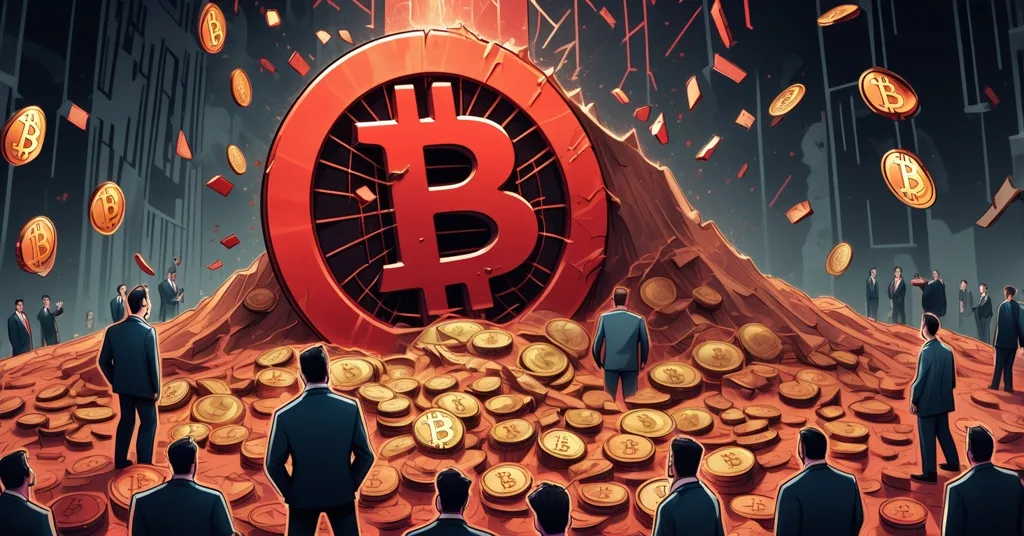Crypto Markets Lose $1B in Liquidations as US Rejects Bitcoin Reserve Purchases

Crypto Markets Bleed $1B in Liquidations as US Rejects Bitcoin Reserve Purchases
A staggering $1 billion in crypto derivatives liquidations hit traders like a freight train this week, just as US Treasury Secretary Scott Bessent dropped a bombshell: the government won’t be buying Bitcoin for its Strategic Bitcoin Reserve. This brutal combo of market chaos and policy clarity—or lack thereof—sent Bitcoin tumbling from record highs, exposing the wild risks and raw volatility that still define this space.
- US Policy Shock: No Bitcoin purchases for the Strategic Reserve; instead, confiscated assets worth $15-20 billion will be used.
- Market Carnage: Bitcoin falls from $124,000 to $118,000, with $1 billion in liquidations, $747 million from long positions.
- Policy Tension: Trump’s “crypto capital” vision clashes with Treasury caution, while altcoins like Ethereum suffer massive losses.
Let’s slice through the hype and get to the core of this mess. US Treasury Secretary Scott Bessent made it crystal clear that the government isn’t planning to shell out taxpayer money to stack Bitcoin for the much-discussed Strategic Bitcoin Reserve. Instead, they’ll build it using confiscated assets—think Bitcoin seized from criminal operations or illicit markets—valued at a hefty $15-20 billion. Bessent didn’t mince words on this strategy:
“The government doesn’t plan to buy Bitcoin.”
He doubled down, adding a twist: “The US will build it up using confiscated assets.” On top of that, the government will halt sales of its existing Bitcoin holdings, which, per data from Arkham, amount to nearly 200,000 BTC. That’s a significant stash, and holding off on dumping it could, in theory, prevent further downward pressure on Bitcoin’s price. But the market’s knee-jerk reaction to the “no buy” news? Pure havoc.
Market Meltdown: A $1B Liquidation Bloodbath
Bitcoin had just clawed its way to a dazzling peak of $124,000 before nosediving to $118,000 in mere hours—a drop of over 2% in a single day. Some data points peg the high a bit lower at $121,000, but the exact figure isn’t the point; the panic is. Compounding the chaos was hotter-than-expected US Producer Price Index (PPI) data, showing a 3.3% year-over-year increase against a forecast of 2.5%. This inflation signal, combined with Bessent’s announcement, brewed a perfect storm for crypto traders, especially those knee-deep in the high-risk world of derivatives, as detailed in recent market volatility reports.
For those new to the game, derivatives are financial contracts like futures or options that let traders bet on price movements of assets like Bitcoin or Ethereum without actually owning them. Often leveraged—meaning you control a big position with little capital—they’re a gambler’s dream until the market flips. When it does, you’re forced to liquidate, losing your stake in a flash. That’s what happened to nearly $1 billion in positions within 24 hours, per CoinGlass liquidation data. Long positions, where traders bet on prices rising, got obliterated to the tune of $747 million. Ethereum led the liquidation slaughter at $312 million, with Bitcoin following at $214 million, Solana at $66 million, and XRP at $56 million. Why did Ethereum take the biggest hit? Likely due to its own rally near an all-time high of around $4,800 before cratering over 5% to below $4,500, coupled with sky-high leverage ratios on some exchanges. Altcoins, as always, catch Bitcoin’s cold when it sneezes.
US Treasury’s Bitcoin Reserve Play: Caution Over Hype
While traders licked their wounds, a deeper issue bubbled up from Washington. Bessent’s refusal to buy Bitcoin directly, even as he floated “budget-neutral pathways” in a follow-up post on X, sends a mixed signal to a market desperate for institutional validation. Budget-neutral, for the uninitiated, means acquiring Bitcoin without dipping into public funds—think more seizures from criminal busts or other creative, non-spending strategies. The US already holds nearly 200,000 BTC from forfeitures tied to illegal activities, forming the backbone of the reserve, which was formalized earlier this year under Trump’s executive orders as part of a broader US Digital Asset Stockpile. For more on the implications of this policy, check out this discussion on potential challenges.
But here’s the rub: federal agencies missed key deadlines in April and May 2025 to deliver reports on how to grow this reserve without taxpayer cost, per Trump’s directives. That delay raises serious questions about whether the government is truly geared up to execute this vision. While halting sales of existing holdings is a subtle nod to Bitcoin’s long-term value, the “no purchase” stance risks dampening the bullish momentum a direct government buy could spark. It’s a safe play, sure, but safe doesn’t always scream innovation in a space built on disruption, as noted in Bessent’s recent statement on the reserve strategy.
Trump’s Crypto Vision vs. Treasury Hesitance
Zooming out, there’s a glaring tension in Washington’s approach to crypto. President Donald Trump is hell-bent on making the US the “crypto capital of the world,” and federal agencies are stepping up to match that rhetoric. The Securities and Exchange Commission (SEC) has rolled out Project Crypto—details are thin, but the intent is clear—while the Commodity Futures Trading Commission (CFTC) is driving its Crypto Sprint initiative. CFTC Acting Chairman Caroline D. Pham laid it out bluntly:
“The CFTC is wasting no time in fulfilling President Trump’s vision to make America the crypto capital of the world.”
Since January 2025, the CFTC has hosted a Crypto CEO Forum, scrapped outdated regulatory advisories, issued fresh guidance for clarity, and opened public comment periods on 24/7 trading and perpetual derivatives (futures contracts with no expiration, often used for high-stakes bets). That’s a full-throttle push for innovation, as highlighted in recent CFTC updates on crypto policy. Yet, it clashes head-on with the Treasury’s risk-averse stance on Bitcoin purchases. Is this a bureaucratic tug-of-war between caution and disruption? Arguably, that friction could fuel a much-needed debate on how far the state should wade into crypto waters.
Macro Pressures and Crypto’s Interconnected Web
Beyond policy, let’s not ignore the broader economic headwinds fanning this fire. The US PPI data jumping to 3.3%—the highest since February—signaled inflation pressures that spook traditional markets and crypto alike. When inflation runs hot, expectations of tighter monetary policy (like interest rate hikes) can sap risk assets like Bitcoin, often seen as speculative despite its “digital gold” moniker. The GMCI 30 index, a benchmark tracking the top 30 cryptocurrencies by market cap, also slid 4% during this turmoil, proving the pain wasn’t Bitcoin’s alone.
Ethereum’s stumble below $4,500, despite its bullish run fueled by staking dynamics post-Merge (a major 2022 upgrade slashing energy use), shows how intertwined this ecosystem is. Solana’s speed-focused blockchain and XRP’s cross-border payment niche couldn’t shield them from losses either, as evidenced by recent analysis of crypto derivatives losses. For Bitcoin maximalists like myself, it’s tempting to shrug off altcoin drama, but let’s be real: these chains fill gaps Bitcoin doesn’t aim to. Smart contracts on Ethereum, lightning-fast transactions on Solana—they’re pieces of this financial revolution. Still, when the king stumbles, the court tumbles too.
What’s Next for Bitcoin and the Strategic Reserve?
Looking ahead, the US sitting on 200,000 BTC without selling is a quiet flex—a signal they see enduring value in this asset. But their reluctance to buy more, even with vague promises of budget-neutral growth, might stunt the adoption momentum we’re hungry for. Could Bessent’s stance soften if political pressure mounts or if “crypto capital” rhetoric gains traction? Possibly. Upcoming CFTC and SEC actions, like further regulatory clarity or 24/7 trading frameworks, could also steady market nerves. For traders, though, this $1 billion wipeout is a glaring reminder: over-leveraging in a volatile market is a one-way ticket to ruin. For long-term holders, the US reserve holdings might still be a bullish sign, even if short-term pain stings, as discussed in community reactions on Bitcoin market crash forums.
On a practical note, retail investors should take this as a wake-up call. Risk management tools like stop-loss orders—automatic sell triggers at a set price—can limit damage in such crashes. Meanwhile, HODLers might find solace in the government’s no-sell policy, despite the lack of fresh buying. But the bigger picture remains murky: if Washington can’t align on coherent policy, it’s just another reason Bitcoin’s decentralized roots matter. No reliance on bureaucratic whims—that’s the promise we’re fighting for.
Key Takeaways and Questions to Chew On
- What’s the US government’s stance on buying Bitcoin for its Strategic Reserve?
They’re not purchasing any directly, per Treasury Secretary Scott Bessent, but will use confiscated assets worth $15-20 billion and halt sales of existing holdings. - How did the crypto market react to this policy news?
It cratered—Bitcoin dropped from $124,000 to $118,000, and nearly $1 billion in derivatives positions were liquidated, with long bets losing $747 million in 24 hours. - Which cryptocurrencies suffered the most in this liquidation wave?
Ethereum took the hardest hit at $312 million in liquidations, followed by Bitcoin at $214 million, Solana at $66 million, and XRP at $56 million. - Is the US fully aligned on crypto under Trump’s leadership?
Not quite—Trump pushes for the US to be the “crypto capital of the world” with SEC and CFTC backing, but the Treasury’s hesitance on Bitcoin buys reveals internal friction. - What are confiscated assets, and why do they matter for the reserve?
These are Bitcoin and other crypto seized from illegal activities, used to grow the reserve without taxpayer cost, reflecting a low-risk approach by the government. - How can traders protect themselves from such volatility?
Use risk management tools like stop-loss orders, avoid over-leveraging, and diversify bets—crypto’s Wild West isn’t forgiving to reckless speculation.
Final Thoughts on Decentralization and the Road Ahead
Here’s my unfiltered take: the US government holding Bitcoin without selling validates its potential as digital gold, but their waffling on direct purchases risks centralizing influence over what’s meant to be free from state control. The $1 billion liquidation debacle isn’t just a market hiccup—it’s a neon sign flashing “caution” to overzealous traders chasing moonshot hype. Stop betting the farm on rocket emoji tweets; respect the beast you’re riding. Meanwhile, Trump’s vision for a crypto-centric America is something I’m rooting for, but only if it’s backed by clear, actionable policy, not just soundbites. Crypto doesn’t need a knight in shining armor; it needs consistency. Until Washington delivers that, the bumpy road to adoption continues. Good thing decentralization means we don’t have to wait for permission to keep building.



